
The data show that “in about 20 years, half the population will live eight states,” a headline in the Washington Post reported.
Those data come from the Weldon Cooper Center at the University of Virginia, which in turn assembles numbers from the U.S. Census.
And they show that the United States will become “less democratic” because so much power in the U.S. Senate will be wielded by Red State white voters.
That, for the Post and some others, is worrisome.
The Data
Some background is necessary before unpacking the Post’s population story.
The observations were triggered by Paul Waldman, a writer for the Post’s Plum Line blog. He thinks “we’re living in age of minority rule” not because of race, but because Republicans control the government even though they received fewer votes than Democrats.
Wrote Waldman:
I added up all the votes cast for Democrats and Republicans in the 2012, 2014 and 2016 Senate elections, which put the current Senate in place. I didn’t bother with the few special elections since 2012, which in total wouldn’t change the results much, but I did include Bernie Sanders’s and Angus King’s last elections, since they are nominally independent but caucus with the Democrats. Here are the results:
Republican votes: 102.3 million
Democratic votes: 117.4 million
In the elections that determined the current Senate, there were 15 million more votes cast for Democrats than for Republicans. Yet Republicans maintain control and therefore get to confirm President Trump’s Supreme Court nominee.
Waldman says the framers of the Constitution made it that way, giving two senators to every state, population regardless, “but that doesn’t mean it’s fair or right or that Democrats shouldn’t be livid in cases like this where it leads to such an antidemocratic outcome. And the GOP’s built-in advantages combine to make the country much more hostile to the policies the majority actually wants.”
And the electoral college, which put Donald Trump in the White House, is “another feature of our system with a built-in Republican advantage.”
Waldman is still upset that Trump won the White House, obviously, but the American Enterprise Institute’s Norman Ornstein tweeted this datum to answer Waldman:
I want to repeat a statistic I use in every talk: by 2040 or so, 70 percent of Americans will live in 15 states. Meaning 30 percent will choose 70 senators. And the 30% will be older, whiter, more rural, more male than the 70 percent. Unsettling to say the least.
Why Is This Bad?
Riffing off Orntsein and Waldman, the Post crunched some of Weldon Cooper’s data, noting that eight states will have about 49.5 percent of the country’s population by 2040, and that the “next eight most populous states will account for an additional fifth of the population, up to 69.2 percent — meaning that the 16 most populous states will be home to about 70 percent of Americans.”
The Post worries about the “the possible anti-democratic effects of the lopsided Senate.”
If conservatives control “states that make up more than two-thirds of the land area of the United States — [they] will similarly control enough of the Senate to overcome any filibuster.”
This, we are to believe, apropos of Ornstein and Waldman, is “unsettling” and “antidemocratic.”
What About Congress?
One must presume from all this that the “unsettling” “antidemocratic’ aspect of this development is that the 30 percent of Americans who choose 70 percent of the Senate will be old and white.
Forgetting that older folks are generally wiser than young folks, Ornstein and the Post aren’t telling readers something else. Right now, for instance, just seven states — California, Texas, Florida, New York, Pennsylvania, Illinois and Ohio — control 195 of the 435 seats in Congress. That’s about 45 percent of the seats controlled completely by 14 percent of the states.
And in California, for instance, a Republican won’t even run for the Senate against Senator Dianne Feinstein in 2020 because of the state’s top-two primary system, which pits the top two vote recipients against each other. Her opponent is State Senator Kevin de León. If both are Democrats, Republicans effectively have no say in which candidate gets that seat unless they vote for a Democrat. In 2016, Senator Kamala Harris’ opponent was not a Republican. It was Democratic Representative Loretta Sanchez.
Electoral Changes
All that said, the population move could affect the Electoral College. Its membership corresponds to each state’s congressional delegation plus its two senators. Right now, each congressman represents 700,000 Americans.
Theoretically, a major population change of the kind suggested in the Post would require the clerk of the House to reapportion seats based upon Census data.
That would not change a state’s number of senators. But it could change the number of congressmen and, thus, a state’s number of electors and, in turn, its power in electing the president. Since so much of the population is predicted to be concentrated in a few states, most of the Electoral College votes would come from those states. There is little doubt, with the social and demographic changes this country is facing, that these states, rather than being “old and white,” will be mostly “young and non-white,” and most likely Democrat. We could very realistically see a situation in which presidential candidates need only campaign in those eight states, plus a few more, as those high-population states will determine the outcome of the race. One could imagine that Democrats, many of whom want to abolish the Electoral College because it is “undemocratic,” would suddenly be in favor of keeping the old institution around.
Democrat presidents, forever, could be the future for the United States. And as the office of the presidency is becoming more and more powerful and Congress seemingly more and more useless, what difference would it make if the Senate was majority Republican? What if the “majority” of U.S. citizens decided to vote to rewrite our Constitution to create a government without a Senate, or with a Senate based on population like the House (which would be superfluous)?
Democracy, essentiallly, is a rule by the majority, and can easily descend into “mob rule” swayed by a powerful leader. America is not (yet) a democracy, but a republic — a nation governed by the rule of law, not necessarily by the will of the majority. This ensures a more peaceful, ordered society. Such a demographic shift, therefore, would not be worrisome for “democracy,” but rather for the future of our Republic.



